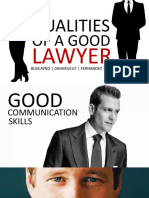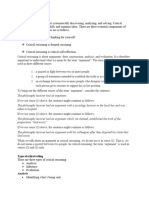0 ratings0% found this document useful (0 votes)
7 viewsCritical Thinking vs Problem Solving
The document discusses the differences between critical thinking and problem solving, emphasizing that while they share skills like analysis and evaluation, not all problems require critical thinking. It highlights the importance of emotional intelligence in both areas and provides strategies for developing critical thinking skills to enhance problem-solving abilities. The content also outlines specific steps to improve analytical skills, evaluation, interpretation, and reflection.
Uploaded by
tmblily2010Copyright
© © All Rights Reserved
Available Formats
Download as DOCX, PDF, TXT or read online on Scribd
0 ratings0% found this document useful (0 votes)
7 viewsCritical Thinking vs Problem Solving
The document discusses the differences between critical thinking and problem solving, emphasizing that while they share skills like analysis and evaluation, not all problems require critical thinking. It highlights the importance of emotional intelligence in both areas and provides strategies for developing critical thinking skills to enhance problem-solving abilities. The content also outlines specific steps to improve analytical skills, evaluation, interpretation, and reflection.
Uploaded by
tmblily2010Copyright
© © All Rights Reserved
Available Formats
Download as DOCX, PDF, TXT or read online on Scribd
You are on page 1/ 5
Critical Thinking vs Problem Solving:
What’s the Difference?
In our blog “Importance of Problem Solving Skills in Leadership,”
we highlighted problem solving skills as a distinct skill set. We
outlined a 7-step approach in how the best leaders solve
problems.
Table of Contents
Critical thinking vs. problem solving
o Critical thinking vs. problem solving: Not all problems
require critical thinking skills
o Critical thinking vs. problem solving: The role of emotional
intelligence
Critical thinking and problem solving: A deeper dive
o A recap of the distinct differences between critical thinking
and problem solving
o How to develop critical thinking skills to become a better
problem solver
1. Develop your analytical skills.
2. Learn the skill of evaluating
3. Interpretation with the help of a mentor or someone
more experienced
4. Acquire the skill and habit of reflection.
Your takeaways:
Critical thinking vs. problem
solving
But are critical thinking and problem solving the same? Also, if
there are differences, what are they? Although many educators
and business leaders lump critical thinking and problem solving
together, there are differences:
Problem solving uses many of the same skills required for
critical thinking; e.g., observation, analysis, evaluation,
interpretation, and reflection. Critical thinking is an important
ingredient of problem solving.
Critical thinking vs. problem solving:
Not all problems require critical thinking
skills
Not every problem-solving skill is a critical thinking skill. That is
because not every problem requires thinking. A problem like
opening a stubborn pickle jar could simply require brute strength.
On the other hand, it becomes a thinking skill when you
remember to tap the edge of the pickle jar lid to loosen the seal.
Also, some problem-solving skills are the exact opposite of critical
thinking. When you follow directions or use muscle memory or
rote (memorization) thinking, there is no critical thinking required.
Likewise, skills of persuasion or public oratory are thinking skills,
but aren’t necessarily critical thinking skills.
Critical thinking vs. problem solving:
The role of emotional intelligence
In our blog “What is the role of communication in critical
thinking?” we highlighted one author’s argument that critical
thinking and problem solving is not always a purely rational
process. While critical thinkers are in great demand in the hiring
marketplace, employees who are emotionally intelligent bring
even greater value to an organization.
Writing for Business News Daily, editor Chad Brooks describes
emotional intelligence as “the ability to understand your emotions
and recognize the emotions and motivations of those around
you.”
So, when looking for star performers, research shows “that
emotional intelligence counts for twice as much as IQ and
technical skills combined in determining who will be a star
performer.”
Further, in today’s collaborative workplace environment, “hiring
employees who can understand and control their emotions – while
also identifying what makes those around them tick—is of the
utmost importance.”
Finally, one expert notes that dealing with emotions is an
important part of critical thinking. Emotions can be at the root of
a problem. They are frequently symptomatic of problems below
the surface. Problem solving when dealing with emotions requires
openness to authentic emotional expressions. It requires the
understanding that when someone is in pain, it is a problem that
is real.
Read More:
The Ultimate Guide To Critical Thinking
Is Critical Thinking A Soft Skill Or Hard Skill?
How To Improve Critical Thinking Skills At Work And
Make Better Decisions
5 Creative and Critical Thinking Examples In Workplace
25 In-Demand Jobs That Require Critical Thinking and
Problem-Solving Skills
Brainstorming: Techniques Used To Boost Critical
Thinking and Creativity
Critical thinking and problem
solving: A deeper dive
A recap of the distinct differences
between critical thinking and problem
solving
Critical thinking, according to an article on Drexel University’s
Graduate College webpage “utilizes analysis, reflection,
evaluation, interpretation, and inference to synthesize information
that is obtained through reading, observing, communicating, or
experience.”
The goal of critical thinking is to evaluate the credibility of both
the information and its source. It questions the central issue and
how the information will inform intelligent decisions. Finally, it
asks the question, “Where does this information lead me?”
Problem solving, as previously mentioned, uses many of those
skills, but “it takes the process a step further to identify obstacles
and then to strategically map out a set of solutions to solve the
problem. That extra step in problem solving is identifying
obstacles as well as mapping out a strategic set of solutions to
resolve the problem.
How to develop critical thinking skills to
become a better problem solver
1. Develop your analytical skills.
Pay attention and be more observant. Ask the questions “who,
what, where, and why” and learn as much as possible about the
topic or problem. Map everything out to imprint or gain a visual
understanding and focus on the differences between fact, opinion,
and your own bias.
2. Learn the skill of evaluating
As a subset of analysis, you can become skilled in evaluation by:
comparing similar and related topics, programs, and
issues. How are they different, and where are the
similarities?
looking for trends that support (or refute) what you
intuitively feel is the solution
recognizing barriers or conflicts to successful problem
resolution
asking questions and gathering information—assuming
nothing, ever.
3. Interpretation with the help of a mentor or
someone more experienced
Interpreting a problem accurately employs both analytical and
evaluating skills. With practice, you can develop this skill, but to
hone your interpretation skills, it is advisable to seek the help of
an experienced mentor.
You’ll need to do the following:
know how your own biases or opinions can be a
roadblock to the best decision making
recognize that cultural differences can be a barrier to
communication
look at the problem from the point of view of others
learn as much as you can about the problem, topic, or
experience
synthesize everything you have learned in order to
make the connections and put the elements of a
problem together to form its solution
4. Acquire the skill and habit of reflection.
Being reflective is applicable to almost every aspect of your
personal and professional life. To open your mind to reflection,
think back to your educational experience. Your instructor may
have asked you to keep a reflective journal of your learning-
related experiences. A reflective journal requires expressive
writing, which, in turn, relieves stress.
Perhaps you have just had a disagreement with a coworker, who
became abusive and personal. Not everyone can come up with
those instant snappy comebacks on the spot, and it is usually
best to disengage before the situation gets worse.
Here’s where reflective journaling helps. When you’re in a calmer
state of mind, you can journal the incident to:
gain deeper insights into your thought processes and
actions—How do you feel about not defending yourself
from the colleague’s accusations or personal abuse?
What was the perfect response that eluded you in the
stress of the moment?
build a different approach to problems—It could be that
your co-worker perceives you as unapproachable or
unreceptive to suggestions and criticism. Maybe it’s
time to have a frank discussion to help you see yourself
through the eyes of the coworker.
get closer to making significant changes in your life—
Your journal entries may have displayed a pattern of
your behavior on the job, which elicits consistent
negative reactions from more than one co-worker.
You might also like
- 5 Important Critical Thinking Skills To Master For StudentsNo ratings yet5 Important Critical Thinking Skills To Master For Students81 pages
- Beginners Guide to Critical Thinking and Problem Solving: Become a Better Critical Thinker & Problem Solver, by Using Secret Tools & Techniques That Will Boost These Skills & Your Decision Making Now!From EverandBeginners Guide to Critical Thinking and Problem Solving: Become a Better Critical Thinker & Problem Solver, by Using Secret Tools & Techniques That Will Boost These Skills & Your Decision Making Now!5/5 (39)
- Activity Sheet in Philosophy of Human Nature Grade 15No ratings yetActivity Sheet in Philosophy of Human Nature Grade 154 pages
- A3 - 3Q - Trends, Networks, and Critical Thinking in The 21st CenturyNo ratings yetA3 - 3Q - Trends, Networks, and Critical Thinking in The 21st Century3 pages
- Critical Thinking & Dark Psychology Secrets 101: Beginners Guide for Problem Solving and Decision Making skills to become a better Critical Thinker, then Learn the art of reading people & Manipulation!From EverandCritical Thinking & Dark Psychology Secrets 101: Beginners Guide for Problem Solving and Decision Making skills to become a better Critical Thinker, then Learn the art of reading people & Manipulation!5/5 (44)
- A Guidebook for Mastering Critical Thinking Skills: Sharpen Your MindFrom EverandA Guidebook for Mastering Critical Thinking Skills: Sharpen Your MindNo ratings yet
- Activity Sheet in Philosophy of Human Nature Grade 15No ratings yetActivity Sheet in Philosophy of Human Nature Grade 155 pages
- HOW TO BUILD A MINDSET OF CRITICAL THINKINGNo ratings yetHOW TO BUILD A MINDSET OF CRITICAL THINKING9 pages
- 7 of The Most Common Types of Thinking and How To Identify Yours - Mindvalley BlogNo ratings yet7 of The Most Common Types of Thinking and How To Identify Yours - Mindvalley Blog6 pages
- Chapter 7 - Critical and Creative ThinkingNo ratings yetChapter 7 - Critical and Creative Thinking18 pages
- Baker, G.S. - CRITICAL THINKING - A Profound Handbook To Improve Your Memory and Logical Skills, Level Up Your Decision Making and Problem Solving!-Independently Published (2020)No ratings yetBaker, G.S. - CRITICAL THINKING - A Profound Handbook To Improve Your Memory and Logical Skills, Level Up Your Decision Making and Problem Solving!-Independently Published (2020)96 pages
- Critical Thinking: Critical Thinking Is The Ability To Think in An Organized and Rational Manner in Order To UnderstandNo ratings yetCritical Thinking: Critical Thinking Is The Ability To Think in An Organized and Rational Manner in Order To Understand5 pages
- Thinkingstyles: Preference Indicator OverviewNo ratings yetThinkingstyles: Preference Indicator Overview14 pages
- Critical Thinking and Creative Thinking PPT 123No ratings yetCritical Thinking and Creative Thinking PPT 12332 pages
- Critical Thinking A To Lin PresentationNo ratings yetCritical Thinking A To Lin Presentation27 pages
- Critical Thinking: 8 Surprisingly Effective Ways To Improve Critical Thinking Skills. Think Fast, Smart and Clear (Improve Logic and Analytical Skills)From EverandCritical Thinking: 8 Surprisingly Effective Ways To Improve Critical Thinking Skills. Think Fast, Smart and Clear (Improve Logic and Analytical Skills)4/5 (11)
- CONTENT on Critical Thinking, Decision Making, DelegationNo ratings yetCONTENT on Critical Thinking, Decision Making, Delegation28 pages
- FDSC Supporting Innovation in Health and Social Care Personal and Professional Development, Level 4, 20 Credits Assessment BriefNo ratings yetFDSC Supporting Innovation in Health and Social Care Personal and Professional Development, Level 4, 20 Credits Assessment Brief14 pages
- Critical Thinking for Beginners: A Step-by-Step Guide to Sharpen Your MindFrom EverandCritical Thinking for Beginners: A Step-by-Step Guide to Sharpen Your MindNo ratings yet
- 7 Critical Thinking Skills: Examples and Ways To ImproveNo ratings yet7 Critical Thinking Skills: Examples and Ways To Improve3 pages
- Critical Thinking Is The Ability To Think Clearly and Rationally About What To Do or What To BelieveNo ratings yetCritical Thinking Is The Ability To Think Clearly and Rationally About What To Do or What To Believe16 pages
- Sanchez Rick Jerold DISC and MotivatorsNo ratings yetSanchez Rick Jerold DISC and Motivators11 pages
- Workshop 1 - Problem Solving Kate PerezNo ratings yetWorkshop 1 - Problem Solving Kate Perez10 pages
- English10 Q2 Mod3 FormulatingAStatementofOpinionorAssertionNo ratings yetEnglish10 Q2 Mod3 FormulatingAStatementofOpinionorAssertion20 pages
- Modern Technologies Positive and Negative Impact in EducationNo ratings yetModern Technologies Positive and Negative Impact in Education2 pages
- Health7 - q1 - Mod3 - Changes That Happen To Adolescents - FINAL08032020100% (1)Health7 - q1 - Mod3 - Changes That Happen To Adolescents - FINAL0803202023 pages
- Indonesian Journal of English Language Teaching and Applied LinguisticsNo ratings yetIndonesian Journal of English Language Teaching and Applied Linguistics21 pages
- Second Periodical Test in Math 2018 PDFNo ratings yetSecond Periodical Test in Math 2018 PDF22 pages
- Skripsi - Rahma Matsna Aulia - 12202244013No ratings yetSkripsi - Rahma Matsna Aulia - 12202244013260 pages
- Guidance in The Philippine School SystemNo ratings yetGuidance in The Philippine School System4 pages
- Types of Paragraphs: What Are The Essential Characteristics of A Good Paragraph?No ratings yetTypes of Paragraphs: What Are The Essential Characteristics of A Good Paragraph?2 pages
- Major Research Project (MRP) : Prestige Institute of Management and Research, IndoreNo ratings yetMajor Research Project (MRP) : Prestige Institute of Management and Research, Indore7 pages
- Updated Complete Handouts EDU305 (Lec 1-45)No ratings yetUpdated Complete Handouts EDU305 (Lec 1-45)289 pages
- 5 Important Critical Thinking Skills To Master For Students5 Important Critical Thinking Skills To Master For Students
- Think Critically, Solve Problems: Achieve SuccessFrom EverandThink Critically, Solve Problems: Achieve Success
- Beginners Guide to Critical Thinking and Problem Solving: Become a Better Critical Thinker & Problem Solver, by Using Secret Tools & Techniques That Will Boost These Skills & Your Decision Making Now!From EverandBeginners Guide to Critical Thinking and Problem Solving: Become a Better Critical Thinker & Problem Solver, by Using Secret Tools & Techniques That Will Boost These Skills & Your Decision Making Now!
- Activity Sheet in Philosophy of Human Nature Grade 15Activity Sheet in Philosophy of Human Nature Grade 15
- A3 - 3Q - Trends, Networks, and Critical Thinking in The 21st CenturyA3 - 3Q - Trends, Networks, and Critical Thinking in The 21st Century
- Critical Thinking & Dark Psychology Secrets 101: Beginners Guide for Problem Solving and Decision Making skills to become a better Critical Thinker, then Learn the art of reading people & Manipulation!From EverandCritical Thinking & Dark Psychology Secrets 101: Beginners Guide for Problem Solving and Decision Making skills to become a better Critical Thinker, then Learn the art of reading people & Manipulation!
- A Guidebook for Mastering Critical Thinking Skills: Sharpen Your MindFrom EverandA Guidebook for Mastering Critical Thinking Skills: Sharpen Your Mind
- Activity Sheet in Philosophy of Human Nature Grade 15Activity Sheet in Philosophy of Human Nature Grade 15
- Critical Thinking Junkie: How to Develop Critical ThinkingFrom EverandCritical Thinking Junkie: How to Develop Critical Thinking
- 7 of The Most Common Types of Thinking and How To Identify Yours - Mindvalley Blog7 of The Most Common Types of Thinking and How To Identify Yours - Mindvalley Blog
- Baker, G.S. - CRITICAL THINKING - A Profound Handbook To Improve Your Memory and Logical Skills, Level Up Your Decision Making and Problem Solving!-Independently Published (2020)Baker, G.S. - CRITICAL THINKING - A Profound Handbook To Improve Your Memory and Logical Skills, Level Up Your Decision Making and Problem Solving!-Independently Published (2020)
- Critical Thinking: Critical Thinking Is The Ability To Think in An Organized and Rational Manner in Order To UnderstandCritical Thinking: Critical Thinking Is The Ability To Think in An Organized and Rational Manner in Order To Understand
- How to Think More Effectively: Functional Health SeriesFrom EverandHow to Think More Effectively: Functional Health Series
- Critical Thinking: 8 Surprisingly Effective Ways To Improve Critical Thinking Skills. Think Fast, Smart and Clear (Improve Logic and Analytical Skills)From EverandCritical Thinking: 8 Surprisingly Effective Ways To Improve Critical Thinking Skills. Think Fast, Smart and Clear (Improve Logic and Analytical Skills)
- CONTENT on Critical Thinking, Decision Making, DelegationCONTENT on Critical Thinking, Decision Making, Delegation
- Unlock Your Mind Mastering Critical Thinking For SuccessFrom EverandUnlock Your Mind Mastering Critical Thinking For Success
- FDSC Supporting Innovation in Health and Social Care Personal and Professional Development, Level 4, 20 Credits Assessment BriefFDSC Supporting Innovation in Health and Social Care Personal and Professional Development, Level 4, 20 Credits Assessment Brief
- Critical Thinking for Beginners: A Step-by-Step Guide to Sharpen Your MindFrom EverandCritical Thinking for Beginners: A Step-by-Step Guide to Sharpen Your Mind
- 7 Critical Thinking Skills: Examples and Ways To Improve7 Critical Thinking Skills: Examples and Ways To Improve
- Critical Thinking Is The Ability To Think Clearly and Rationally About What To Do or What To BelieveCritical Thinking Is The Ability To Think Clearly and Rationally About What To Do or What To Believe
- English10 Q2 Mod3 FormulatingAStatementofOpinionorAssertionEnglish10 Q2 Mod3 FormulatingAStatementofOpinionorAssertion
- Modern Technologies Positive and Negative Impact in EducationModern Technologies Positive and Negative Impact in Education
- Health7 - q1 - Mod3 - Changes That Happen To Adolescents - FINAL08032020Health7 - q1 - Mod3 - Changes That Happen To Adolescents - FINAL08032020
- Indonesian Journal of English Language Teaching and Applied LinguisticsIndonesian Journal of English Language Teaching and Applied Linguistics
- Types of Paragraphs: What Are The Essential Characteristics of A Good Paragraph?Types of Paragraphs: What Are The Essential Characteristics of A Good Paragraph?
- Major Research Project (MRP) : Prestige Institute of Management and Research, IndoreMajor Research Project (MRP) : Prestige Institute of Management and Research, Indore

























































































